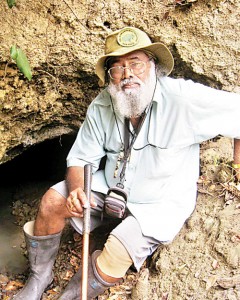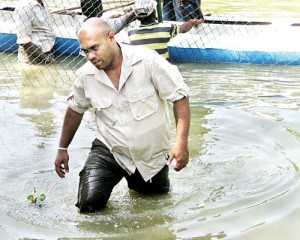On a historical hunt for crocs and baby bait
A passing reference about a frayed and yellowed news clipping stunned him – up to that time the virtual ‘Crocodile Man’ of Sri Lanka thought he knew quite a lot about this reptile and its associations in this country.
The snippet mentioned in an evening in May 2013 after hectic sessions of the World Crocodile Conference, made him aghast. The lure of the old newspaper clipping was ‘babies as bait’ for crocodiles in the Sri Lanka of yore.
“Cingalese mothers regularly hire out their babies as crocodile bait…………..‘Baby bait is the only thing for crocodiles and everyone uses it. You rent a baby down there for two shillings a day. Of course, the thing isn’t as cruel as it sounds. ……… The babies are simply set on the soft mud bank of a crocodile stream and the hunter lies hid near them — a sure protection. The crocodile is lazy. He basks in the sun in mid-stream. Nothing will draw him to the shore where we can pot him. But set a little fat naked baby on the bank, and the crocodile soon rises up. In he comes, a greedy look in his dull eyes, and then you open fire. Some Cingalese women make as much as 8s a week out of renting their babies for bait’.”
It was then that well-known herpetologist, Anslem de Silva, who is the Regional Chairman for South Asia and Iran of the Crocodile Specialist Group (CSG) of the International Union for Conservation of Nature (IUCN)/Species Survival Commission (SSC) decided he would go after the story behind the story which had been published in the ‘Kilmore Free Press’ in America, on June 1, 1911.
Mr. de Silva’s search, along with Ruchira Somaweera, Senior Zoologist, Biologic Environmental Survey and Visiting Scientist, CSIRO Ecosystem Sciences, Australia, has yielded amazing results.
The research titled, ‘Were human babies used as bait in crocodile hunts in colonial Sri Lanka?’ has now been published in the ‘Journal of Threatened Taxa’ on January 26.
When Mr. de Silva, who virtually had all references pertaining to Sri Lanka on herpetology or so he thought, first saw the clipping, his surprise had known no bounds.
It had been CSG Regional Chairman, Australia & Oceania and Editor, CSG Newsletter, Charlie Manolis, who had told him that he had an old paper clipping relating to Sri Lanka crocodiles, when that May evening’s chat had centred on some crocodile attacks in Sri Lanka over a thousand years back (Mahavamsa) mentioned in Mr. de Silva’s book.
It disturbed Mr. de Silva who was then spurred towards this research and contacted an American museum and managed to get “some super old press accounts” of baby bait. When he asked Mr. Somaweera for comments, he too had come on board.
“There had been no reference to baby bait in Sri Lanka that I knew of. It was then that I searched for and got down papers published during the 1800s,” Mr. de Silva, adding that many have been the plaudits since the research paper was published in January.
“This is perhaps the fastest that I have seen any herp news travel!” Professor and Head, Department of Biology, Utah State University, Alan H. Savitzky, had emailed him, adding: “I love historical papers, so keep working on them! Actually, your paper about using babies as bait apparently has been travelling very quickly around e-mail circles.”
It was also in 2013, soon after seeing the baby-bait clipping that Mr. de Silva contacted the Sunday Times querying whether we were aware of ‘baby bait for crocodiles’.
Explaining that he knew that it was done in a few countries in the world some time back, but not in Sri Lanka and that he also knows of the practice of “tying a dog to attract crocodiles, done even today in this country”, he requested a small insertion in the Sunday Times seeking from the public “some evidence of this gruesome thing”.
Mr. de Silva’s efforts not only in approaching the media but also firing off numerous e-mails to his extensive contacts across the world have resulted in this interesting historical paper.
While conceding that the use of live animals as bait is not an uncommon practice in hunting worldwide, the paper points out however that “some curious accounts” of the use of human babies as bait to lure crocodiles in sport hunting exist on the island of Sri Lanka, where sport hunting was common during the British colonial period.

Anslem de Silva
Pointing out that hunting for sport is one of the oldest recreational uses of wildlife and existed for more than 2,500 years since Ancient Greek times, the paper explains that it was largely practised by royalty, the upper social classes and colonial rulers and that among the many large animals hunted for sport were crocodilians in the 19th and 20th centuries.
Among the many historical reports of hunting crocodiles on the island, as stated in the research paper are:
n Three interesting sketches of the method of using a baby to lure a large crocodile in the London-based ‘The Graphic’ of January 21, 1888 captioned ‘Sport in Ceylon—Shooting a Man-eating Crocodile’ depicting a European estimating the size of a crocodile to be a ‘twenty footer’; hiring a baby from the locals as bait; and the concealed hunter shooting the crocodile that has been lured to the baby tied to a bush on the bank. The preferred bait is specified as ‘a chubby, rice-distended and squally infant’. (see sketch which had been sourced online through Hughes by the researchers)
n Several contemporaneous newspapers including ‘The Red Cloud Chief’ of April 6, 1888, ‘The Helena Independent’ of April 18, 1890, the ‘Desert Evening News’ of April 29, 1890, the ‘Roanoke Times’ of July 20, 1890 had each contained a news item titled, ‘Babies for Crocodile Bait’. They had all referred to a newspaper advertisement captioned ‘Babies wanted for crocodile bait. Will be

Ruchira Somaweera
returned alive’ that was published in the Ceylonese newspaper, the ‘Ceylon Catholic Messenger’.
While Mr. de Silva and Mr. Somaweera state that attempts to locate the original article failed, the note which appeared in the ‘Roanoke Times’ has been reproduced, which states that Ceylonese parents have “unbounded” confidence in English crocodile hunters. They would rent their babies out to be used as bait to lure crocodiles for a small consideration and it is not difficult for an English crocodile hunter to secure the bait (Mower County Transcript: 23 July 1890). When the crocodiles are attracted to the dark-brown infant on the bank, the hidden hunter would shoot the animal as it approaches the live ‘bait’. The sportsman would then secure the skin and the head of the crocodile, and the natives would make use of the rest of the carcass. Some report that “the baby is taken home to its loving parents, to be used for the same purpose next day”.
n The ‘Omaha Daily Bee’ of March 5, 1888, the ‘Western Kansas World’ of June 30, 1888 and the ‘Barton County Democrat’ of March 29, 1888 have referred to these reports and stated that “this way of securing crocodiles might be objected to by American mothers. The American infant imagination might be shuttered by the devouring gaze of a healthy saurian who hasn’t had his dinner; but we are creditably informed by certain English crocodile hunters that the average Ceylon infant displays a passive indifference to his advances, and the only thing which frightens him is the report of the gun”.
The same story seems to have reappeared in ‘The Valentine Democrat’ of October 1, 1896 with a description of how “a nice, fat baby is tied by the leg to a stake near some pond or lagoon where crocodiles abound. Soon the child begins crying and the sound attracts the crocodiles within hearing distance. They start out immediately for the wailing infant……..So expert are many of the hunters that they do not shoot the alligator (correctly, the crocodile) until it has approached to within a few feet of the baby”.
n A third set of reports that appeared in American and Australian newspapers include ‘Babes and Bait’ in the ‘Cameron County Press’ of December 12, 1907, ‘Babies as Bait’ in the ‘Daily News’ (Perth, WA) of April 11, 1908, ‘Baby Bait for Crocodile’ in ‘The Columbian’ of July 2, 1908, ‘Baby Bait for Crocodiles’ in the ‘Healesville and Yarra Glen Guardian’ of August 23, 1910, ‘A New Use for Babies’ in ‘The Southern Record and Advertiser’ of November 26, 1910 and the list goes on.
Of course, the researchers explain that the historical distribution and abundance of the two species of crocodiles which inhabit Sri Lanka — the Saltwater Crocodile (Crocodylus porosus) and the Mugger (C. palustris) were greater than today and they were not legally protected until 1964. The Mahavamsa records that a man-eating crocodile at Gal-Oya was hunted down by King Rajasinghe II (1629-1687 CE).
Records of a similar practice in other countries have also been documented in the paper. One indicates how officers of the British Army went after crocodiles, with Hindu babies as bait with native women flocking to rent their babies for six cents per day and some would not even insist on a guarantee of their safe return (and that some crocodiles in fact got away with the `bait’).
The ex-officer who had been quoted in the article had claimed to have shot more than 100 crocodiles with just one chosen baby girl as bait, while adding that he could not find an infant for rent to follow the same procedure in hunting an alligator in Florida, USA.
Anecdotal reports of the use of human babies as bait for crocodilians do exist, nevertheless, in American newspapers, the researchers state, citing numerous articles including a Washington Times report in 1908 that a keeper at the New York Zoological Garden baited “Alligators with Pickaninnies” (a derogatory term for African-American children) and that “the alligators were ‘coaxed’ ‘into their summer quarters by plump little Africans”.
While in July 1968, the Los Angeles Times had run an article about baseball player Bob Gibson mentioning an inhabitant of Georgia stating that “Negro youngsters” were used in baiting alligators, the practice had also been part of movie plots such as ‘Alligator Bait’ (1900), ‘The Gator and the Pickaninny’ (1900) and ‘Untamed Fury’ (1947), and also used in postcards.
The duo points out that while these early records are fascinating, recent island-wide surveys of crocodilians themselves, their attacks and human perceptions towards crocodiles in Sri Lanka, did not encounter any records or even folklore or myths referring to the use of humans as bait for crocodiles. “However, using live dogs as well as dead animals (chicken, dogs, monkeys, cattle etc.) as bait to lure crocodiles was reported at several locations during our surveys, a practice that has its roots in early Ceylon.”
While acknowledging that many hunting strategies involve live bait to lure prey to the hunter, the researchers state that very few involve using humans as bait. Among the current examples cited by them are members of certain African tribes using their feet as lures to extract pythons from burrows and fishermen in the southern United States ‘noodling’ for large catfish offering their hands as lures.
Going once again to historical times, when hunters sometimes used other humans as bait to attract their prey (African ‘coolies’ to lure lions for shooting during the construction of the Mombasa-Uganda railway in East Africa in 1898), Mr. de Silva and Mr. Somaweera point out that these probably involved adult humans rather than infants.
“Hence these anecdotal reports of using human babies as live bait in sport hunting constitute an important record in early hunting practices, as well as shining a new light on our colonial history,” they add.


